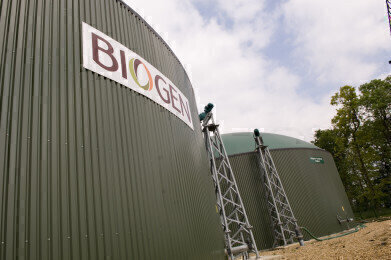Gas Detection
BiogenGreenfinch`s Biogas Talks!
Jul 06 2009
As BiogenGreenfinch builds its next, much larger and first, second-generation anaerobic digestion (AD) facility at Westwood in Northamptonshire, it is making good use of everything it has learned from the construction and operation of its pioneering, commercial food waste AD plant at Twinwoods, Bedfordshire and the new technology now available.
For BiogenGreenfinch the key to successful AD operations includes managing the feed mix and its loading while closely monitoring output biogas gas concentrations with an AEMS system. The Geotech AEMS system continuous gas analyser from Geotech (UK), measures methane (CH4) percentage concentrations and provides a ‘switch on’ signal for combined heat and power (CHP) engines. It also monitors carbon dioxide (CO2), oxygen (O2) and hydrogen sulphide (H2S) with a CHP engine cut-off point to protect the gas engines. The continuous gas analyser data log confirms this for BiogenGreenfinch and gas engine manufacturers are able to see that warranty and service contract conditions have not been breached. With the Geotech AEMS static gas analyser on constant watch and checking gas content at Twinwoods every fifteen minutes, Phil Moffat, BiogenGreenfinch operations manager, says they look for changes and trends in the biogas content. “It is quick and easy because it is done automatically every fifteen minutes,” Phil said. “It is the first thing we see. It helps us to spot any change in the digester health. This makes it possible for us, along with our expertise, to manage the feeding process accordingly.” Each load brings more ‘food fuel’ for the digester and with it, income as a ‘gate fee’ from the supplier. These fees are cost competitive with landfill and AD is acknowledged to be the most environmentally beneficial method for food waste recycling. The gate fee income is an important part of the total business equation. The annual 12,000 tonnes a year of slurry from the 22,000 a year pig-finishing unit on Bedfordia Farms provides the liquid fraction for this AD unit and solved the problem of how to dispose of the slurry in an environmentally sustainable way from the farm. With an annual capacity of 42,000 tonnes a year of slurry and food waste, the plant produces and sells over 1MW of clean renewable electricity back to the National Grid. That is enough to power over 1200 homes continuously and, as a form of ‘green electricity’, earns tradable Renewable Obligation Certificates (ROCs), as well as the income from supplying power to the grid. The Twinwoods AD plant produces 30,000 tonnes of a nutrient-rich liquid bio-fertiliser per annum that can be used back to grow more arable crops. This replaces the need for bought-in manufactured nitrogen fertilisers for the 600Ha arable farm. With its unique experience and AD operating knowhow, BiogenGreenfinch is now looking to roll out its second generation AD plants in partnership with farmers and landowners, food producers and local authorities. BiogenGreenfinch will fund, design, build and operate AD plants and to date has been responsible for twelve AD plants in the UK. The company is to expand its network of AD plants by ten new plants over the next three to five years.Digital Edition
IET 34.2 March 2024
April 2024
Gas Detection - Biogas batch fermentation system for laboratory use with automatic gas analysis in real time Water/Wastewater - Upcycling sensors for sustainable nature management - Prist...
View all digital editions
Events
Apr 30 2024 Melbourne, Australia
Apr 30 2024 Birmingham, UK
May 03 2024 Seoul, South Korea
May 05 2024 Seville, Spain
May 06 2024 Minneapolis, MN, USA


















